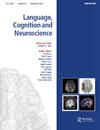Existential negation modulates inhibitory control processes and impacts recognition memory. Evidence from ERP and source localisation data
IF 1.8
3区 医学
Q2 AUDIOLOGY & SPEECH-LANGUAGE PATHOLOGY
引用次数: 0
Abstract
ABSTRACTIt has recently been proposed that comprehension of negation reuses the inhibitory control mechanisms. However, this Reusing Inhibition for Negation (RIN) hypothesis has mostly been confirmed with imperative sentences. The current study examined whether comprehension of negated existential sentences, which are purely declarative, also shares neural resources with inhibitory control processes. Participants read affirmative or negative existential sentences while performing an embedded Go/NoGo task, followed by a recognition probe to test the impact of negation on words activation. Relative to affirmative sentences, negation increased the P3 amplitude for NoGo trials, with estimated sources in the inhibition-related medial and dorsolateral areas in the prefrontal and parietal cortices. These results indicate that existential negation also shares neural mechanisms with inhibitory control, extending the RIN hypothesis. Furthermore, recognising negated words took longer and decreased the readiness potential of the responses compared to affirmed words, suggesting reduced accessibility of negated words in working memory.KEYWORDS: Existential negationinhibitory controlRIN hypothesisrecognition memory Disclosure statementNo potential conflict of interest was reported by the author(s).Notes1 We are grateful to the anonymous reviewers for inspiring us to conduct relevant statistical analyses of the probe recognition data.Additional informationFundingThis research was supported by the Spanish Ministry of Science and Innovation (Grant RTI2018-098730-B-I00 to DB and MdV), and the European Regional Development Funds, and by the Fundamental Research Funds for the Central Universities of China (No. 3132022333).存在否定调节抑制控制过程,影响识别记忆。来自ERP和本地化数据源的证据
摘要最近有研究提出,对否定的理解重复了抑制控制机制。然而,这一假设在祈使句中得到了证实。目前的研究考察了对纯粹陈述性的否定存在句的理解是否也与抑制性控制过程共享神经资源。参与者在阅读肯定或否定存在句的同时执行嵌入式Go/NoGo任务,随后进行识别探测,以测试否定对单词激活的影响。与肯定句相比,否定句增加了NoGo试验的P3振幅,估计其来源是前额叶和顶叶皮层中与抑制相关的内侧和背外侧区域。这些结果表明存在否定与抑制控制也有共同的神经机制,扩展了RIN假说。此外,与肯定词相比,识别否定词需要更长的时间,并降低了反应的准备潜力,这表明否定词在工作记忆中的可及性降低。关键词:存在否定抑制控制rin假设识别记忆披露声明作者未报告潜在利益冲突。注1感谢匿名审稿人对我们进行探针识别数据相关统计分析的启发。本研究得到了西班牙科学与创新部(资助RTI2018-098730-B-I00 to DB和MdV)、欧洲区域发展基金和中央高校基础研究基金(No. 3132022333)的支持。
本文章由计算机程序翻译,如有差异,请以英文原文为准。
求助全文
约1分钟内获得全文
求助全文
来源期刊

Language Cognition and Neuroscience
AUDIOLOGY & SPEECH-LANGUAGE PATHOLOGY-BEHAVIORAL SCIENCES
CiteScore
4.50
自引率
13.00%
发文量
70
期刊介绍:
Language, Cognition and Neuroscience (formerly titled Language and Cognitive Processes) publishes high-quality papers taking an interdisciplinary approach to the study of brain and language, and promotes studies that integrate cognitive theoretical accounts of language and its neural bases. We publish both high quality, theoretically-motivated cognitive behavioural studies of language function, and papers which integrate cognitive theoretical accounts of language with its neurobiological foundations.
The study of language function from a cognitive neuroscience perspective has attracted intensive research interest over the last 20 years, and the development of neuroscience methodologies has significantly broadened the empirical scope of all language research. Both hemodynamic imaging and electrophysiological approaches provide new perspectives on the representation and processing of language, and place important constraints on the development of theoretical accounts of language function and its neurobiological context.
 求助内容:
求助内容: 应助结果提醒方式:
应助结果提醒方式:


